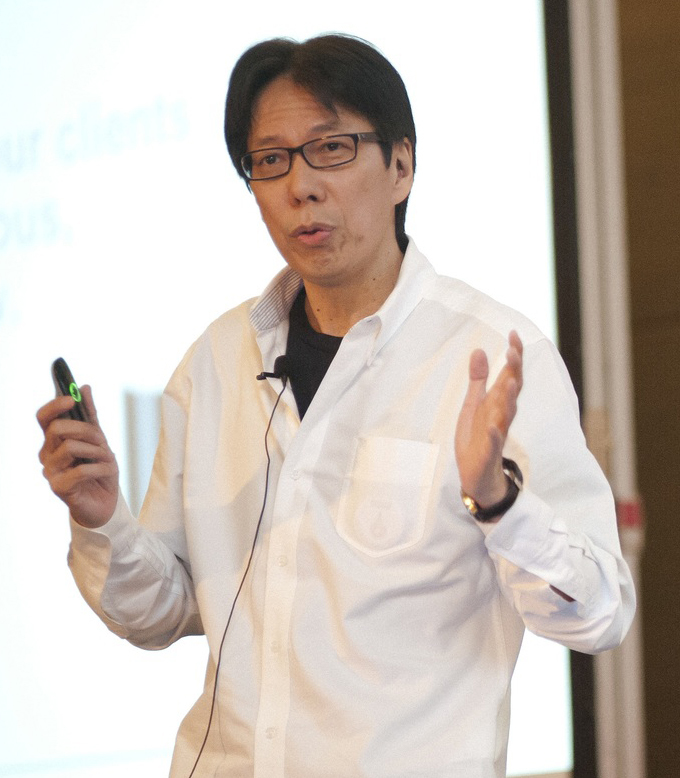Building a Common Language to Tackle Asia's Diversity
──Ted, you serve as CCO for APAC within Dentsu Inc. global network. You give the impression of constantly flying between locations, never "settling down." What role do you currently hold?
I oversee about 30 offices across 10 APAC countries. My role is to clarify the creative vision, shape creative leadership, and sharpen strategic thinking. Then, by delivering creative results, we elevate the network's presence, attract talented creators, and drive the business forward.
Three years ago, when I moved from a Malaysian ad agency to the Dentsu Inc. network, the first thing my team and I did was develop and implement the "Dentsu Innovation Navigator" – a common strategic language covering the entire region. This is our network's unique strategic planning framework. If the strategy is wrong, the creative will miss the mark.
──When tackling diverse client challenges across many countries and regions, is there something you always keep in mind?
I believe that deeply understanding local consumers and culture is essential for business success, regardless of the country. Our role is to ensure clients can consistently meet consumer needs, no matter how diverse those needs are across markets. What works in Japan doesn't necessarily work elsewhere, and vice versa. A brand's success hinges on how well and how quickly it adapts to a rapidly changing environment. We must always act with foresight.
Honestly re-examine the true business challenges with clients
──This demands a keen sense and insight to accurately foresee where consumer needs are headed.
As clients continue to seek growth, we on the corporate side tend to think day and night only about "selling products." How many times has my wife told me, "Stop acting like you're still at the office!"
But we mustn't overlook the crucial difference: corporate people are not the same as the family at home. Corporate people want to sell products. To do that, we first need to find touchpoints with consumers at home—people with entirely different mindsets from the corporate world.
The challenge for creators isn't just about expression; it's about strategically finding the point where the needs of both sides align. I don't know if it's the best term, but I simply call this "fusion of strategic thinking and creativity" Creative Strategy.
──What principles do you hold dear when putting this creative strategy into practice?
It's about thoroughly understanding your own work and field of expertise, and always being sincere.
Clients, even from a distance, possess the discernment to see through things. For example, on a competitive pitch, I was given a brief stating: "We've made a massive investment to secure cable TV slots. We believe everyone understands the brand well. The best storyboard wins."
It would have been easy to follow the instructions. However, I questioned what the real business challenge was. The brand was popular with older audiences, but younger people avoided it, feeling it wasn't for them. I pointed this out and proposed, "We should target the younger generation, who are the brand's next generation of consumers, and rethink the media strategy."
They agreed our point was valid. They also appreciated our approach of not just responding to the client's request, but of digging deep to identify the real challenge the brand needed to address. I believe this success came from clearly understanding what we could achieve with our expertise and engaging sincerely with the client.
Aiming for Hits Across All Locations to Boost Presence
──The network's remarkable progress since Ted assumed the role of APAC CCO is evident in our advertising award wins.
We are maintaining our existing business while actively pursuing new opportunities. The number of offices and works winning awards has increased dramatically, and the range of award categories has broadened to include digital, innovation, intellectual property, and more. We believe this is due to the combined strength of the creative process we introduced, the hard work of our talented staff, and the support from both regional and local management.
──How will you strengthen your network and locations to become a better business partner for clients?
What we do is a "people business"—our greatest asset is our people. We recruit and inspire talented individuals committed to our goals. When they earn the trust and respect of our clients, it leads to strong results and profitability.
──Finally, what are your aspirations for 2016?
We will create work across all our locations that captures people's attention and gets shared, through sharper creative strategy and fresher creative expression than ever before. We also want to drive collaboration and innovation across our network. By doing so, we will further enhance Dentsu Inc.'s presence in APAC and grow into an agency where clients and promising talent want to work together—that is my challenge.
There are many other things to do and achieve. There's still no time to rest!
──So your days of moving between locations will continue. I'm concerned about your health, but I'm looking forward to seeing the APAC network's achievements this year too!! Thank you.
Dentsu Inc. Branded Agency Case Study
Singapore Airlines' first social media brand video: "No Detail Is Too Small"
https://www.youtube.com/watch?v=wt99b5ccwqk
Collaborated with a leading paper craft artist to create a perfect miniature of their Airbus A380, accurately replicating every detail down to the seat functions.
Toyota's Internet-Centric Campaign "Do The 'Wakudoki'"
Featuring the globally popular Japanese dance performance unit WORLD ORDER to express "Wakudoki," the campaign aimed to strengthen brand image among young audiences across eight Asian countries including India and Thailand.



